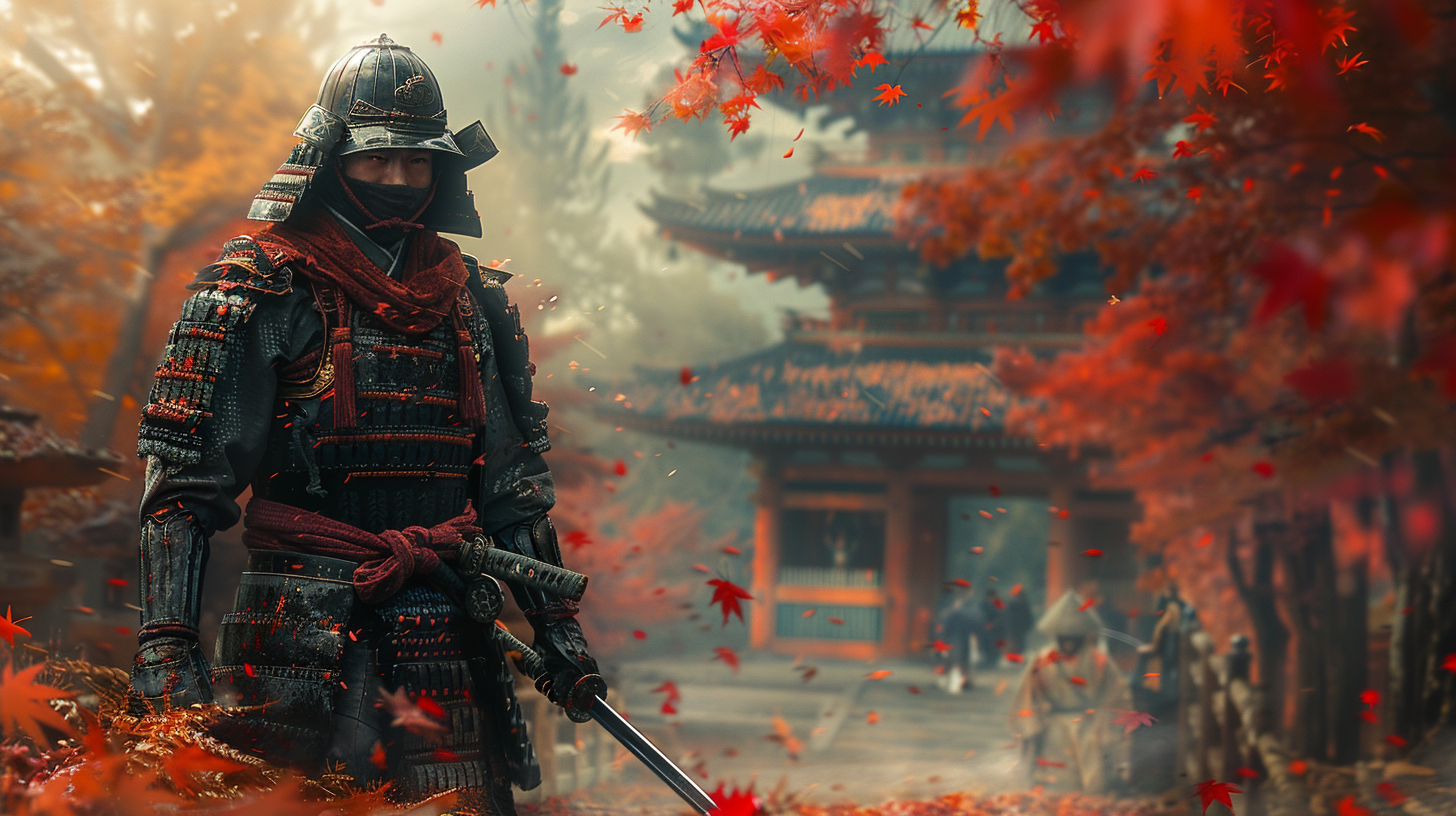はじめに
日本は、その独特な文化と歴史を持つ国として世界に知られています。特に戦前の日本文化は、サムライ精神を中心に形作られ、多くの面で日本人の強さを育んできました。本ブログでは、戦前の日本文化におけるサムライ精神を軸に、日本人の強さを心理面、教育面、文化的背景、そして研究開発の各視点から探ります。
心理面:サムライの武士道精神
武士道とは
武士道は、サムライ階級における道徳的な教えであり、誠、義、勇、仁、礼、名誉といった価値観を重んじます。これらの価値観は、現代の日本人の精神的な基盤となっています。
- 誠(まこと):正直であることを重んじ、誠実な行動を心がける。
- 義(よい):正義を重視し、道義を守る。
- 勇(いさみ):勇気を持ち、困難に立ち向かう。
- 仁(じん):慈悲深く、人々を助ける。
- 礼(れい):礼儀を重んじ、他者に対する敬意を持つ。
- 名誉(めいよ):名誉を重んじ、名を汚さない行動をする。
これらの価値観は、自己犠牲や忠誠心、倫理的行動を重んじる心理的な強さを育んでいました。サムライたちは、これらの価値観を体現し、個人の利益よりも集団や社会全体の利益を優先しました。
忠誠心と自己犠牲
サムライたちは主君や家族、共同体に対する強い忠誠心を持ち、時には自己犠牲を厭わず行動しました。この精神は、現代の日本人の集団主義や協調性にも影響を与えています。例えば、企業における忠誠心やチームワークの重視、社会全体の利益を優先する姿勢などが挙げられます。
教育面:寺子屋から藩校へ
寺子屋教育
江戸時代、寺子屋は庶民教育の中心的存在でした。ここでは読み書きや算術といった基礎的な学問が教えられ、多くの人々が基本的な教育を受けることができました。このような教育システムは、日本人の学力向上に大きく寄与しました。
藩校と武士教育
藩校は、各藩が設置した武士のための教育機関で、武士子弟に対して文武両道の教育が行われました。武士道や儒教の教えを取り入れた教育が行われ、道徳や倫理、礼儀作法が重視されました。このような教育により、武士たちは高い精神性と自己規律を身につけました。
修練と鍛錬
武士の子供たちは、幼少期から剣道や弓道、柔術などの武道を学びました。これにより、身体的な強さだけでなく、精神的な強さや集中力も養われました。これらの修練は、武士としての誇りや自己管理能力を育む重要な要素でした。
文化的背景:社会的価値観と生活様式
集団主義と協調性
日本社会は歴史的に集団主義の文化が強く、個人よりも集団や社会全体の利益を重視する傾向があります。これは、サムライの忠誠心や自己犠牲の精神から発展したものであり、現代の企業文化や社会習慣にも反映されています。
武士階級の影響
武士階級は、社会の上層部を占め、その価値観や生活様式が広く影響を及ぼしました。武士たちは茶道や剣道、書道などの文化活動を嗜み、精神的な修養や集中力、礼儀作法を身につけました。これらの活動は、現代の日本文化にも深く根付いています。
農耕社会の影響
日本は農業を基盤とした社会であり、勤勉さや忍耐力、協力の精神が育まれました。農作業は共同作業が多く、村全体で協力し合うことが求められました。このような社会環境が、日本人の協調性や共同体意識を強化しました。
研究開発:技術革新と工夫
兵法の研究
戦国時代から江戸時代にかけて、武士たちは戦術や戦略に関する研究を盛んに行いました。『孫子』や『五輪書』などの兵法書が学ばれ、これに基づく実戦的な戦術が発展しました。これにより、戦闘力が向上し、武士たちは効果的に戦う術を身につけました。
刀剣の製造技術
日本刀の製造は高度な技術を要し、その技術革新が武士の戦闘力を高めました。刀鍛冶たちは、長年にわたり鍛錬と改良を重ね、高品質な日本刀を生み出しました。この技術は、戦闘だけでなく、美術品としても高く評価されました。
建築技術
城郭や寺院の建築技術が発展し、防御力や美観に優れた構造物が作られました。これにより、戦国時代の戦乱を生き延びるための拠点が確保されました。日本の伝統的な建築技術は、現代の建築物にも影響を与えています。
工芸と科学の発展
日本は陶磁器の製造技術が発展し、高品質な陶磁器が輸出産業として重要な役割を果たしました。また、漢方医学や独自の薬学が発展し、健康管理や治療法の研究が進みました。これにより、健康で強い身体を維持することができました。
まとめ
戦前の日本文化におけるサムライの影響は、心理面、教育面、文化的背景、研究開発の各側面において日本人の強さを形成しました。これらの要素が現代にも引き継がれ、日本人の勤勉さや倫理観、技術力に影響を与えています。
歴史的価値観の再評価
武士道精神や歴史的な教育方法を現代のビジネスや技術開発に応用することで、強固な倫理観とリーダーシップを育成することができます。
集団主義の活用
チームワークや協調性を重視する文化を活かし、大規模なプロジェクトや国際協力において強みを発揮することができます。
技術革新の推進
歴史的な技術革新の精神を受け継ぎ、現代のAI技術や科学研究においても常に先端を目指すことが重要です。
これにより、日本の強みを最大限に活かし、国際競争力を一層高めることが可能です。戦前の日本文化とサムライ精神から学び、現代の課題に対処するための新たな視点を得ることができるでしょう。
The Strength of Japanese Culture Before WWII: Insights from Samurai on Psychology, Education, Cultural Background, and Research and Development
Introduction
Japan is known worldwide for its unique culture and history. Particularly, pre-WWII Japanese culture, centered around the spirit of the samurai, cultivated many aspects of Japanese strength. In this blog, we will explore the strength of the Japanese people based on the samurai spirit, from the perspectives of psychology, education, cultural background, and research and development.
Psychological Aspect: The Samurai's Bushido Spirit
What is Bushido?
Bushido is the moral code of the samurai class, emphasizing values such as sincerity, righteousness, courage, benevolence, respect, and honor. These values form the foundation of modern Japanese psychology.
- Sincerity (Makoto): Emphasizing honesty and sincerity in actions.
- Righteousness (Gi): Prioritizing justice and adhering to moral principles.
- Courage (Yu): Having the bravery to face difficulties.
- Benevolence (Jin): Showing compassion and helping others.
- Respect (Rei): Valuing etiquette and showing respect to others.
- Honor (Meiyo): Upholding one’s honor and avoiding actions that tarnish one's name.
These values cultivated psychological strengths such as self-sacrifice, loyalty, and ethical behavior. Samurai embodied these values, prioritizing the collective good over individual interests.
Loyalty and Self-Sacrifice
Samurai exhibited strong loyalty to their lords, families, and communities, often engaging in self-sacrifice. This spirit influences modern Japanese collectivism and cooperation. For example, loyalty and teamwork in businesses, as well as prioritizing societal benefits, reflect this heritage.
Educational Aspect: From Terakoya to Han Schools
Terakoya Education
In the Edo period, terakoya were the primary educational institutions for commoners. They taught basic academic skills such as reading, writing, and arithmetic, enabling widespread basic education. This educational system significantly contributed to the improvement of Japanese literacy and numeracy.
Han Schools and Samurai Education
Han schools were educational institutions established by feudal domains (han) for samurai. They provided comprehensive education that included both academic and martial training. The curriculum incorporated Bushido and Confucian teachings, emphasizing morality, ethics, and etiquette. This education nurtured high moral standards and self-discipline among samurai.
Training and Discipline
Samurai children were trained in martial arts such as kendo, kyudo, and jujutsu from a young age. This training fostered not only physical strength but also mental fortitude and concentration. Such discipline was crucial for instilling pride and self-regulation in samurai.
Cultural Background: Social Values and Lifestyle
Collectivism and Cooperation
Japanese society historically emphasizes collectivism, prioritizing the collective and societal benefits over individual interests. This trait, stemming from the samurai’s loyalty and self-sacrifice, is evident in modern corporate culture and social practices.
Influence of the Samurai Class
The samurai class occupied the upper echelons of society, and their values and lifestyle had widespread influence. Samurai engaged in cultural activities such as tea ceremony, kendo, and calligraphy, fostering mental refinement, concentration, and etiquette. These activities remain deeply embedded in modern Japanese culture.
Influence of Agricultural Society
Japan’s agrarian-based society cultivated diligence, perseverance, and cooperation. Agricultural work required collective effort, fostering a strong sense of community and teamwork. This social environment reinforced the Japanese inclination towards cooperation and community spirit.
Research and Development: Technological Innovation and Ingenuity
Study of Military Tactics
From the Sengoku period to the Edo period, samurai actively studied military tactics and strategies. Texts such as "The Art of War" and "The Book of Five Rings" were studied, leading to the development of effective combat strategies. This enhanced the combat abilities of samurai, enabling them to fight more effectively.
Sword-Making Techniques
The manufacture of Japanese swords required advanced techniques, and continuous innovation in these techniques enhanced the combat effectiveness of samurai. Swordsmiths dedicated themselves to honing and improving their craft, producing high-quality Japanese swords. This technology was not only vital for combat but also highly valued as art.
Architectural Techniques
The development of castle and temple construction techniques resulted in structures with superior defense capabilities and aesthetics. These structures served as vital fortifications during the turbulent Sengoku period. Traditional Japanese architectural techniques continue to influence modern architecture.
Advancement in Crafts and Medicine
Japan developed advanced ceramic manufacturing techniques, producing high-quality ceramics that played a significant role in export industries. Additionally, traditional Japanese medicine and pharmacology advanced, improving health management and treatment methods, thereby maintaining strong and healthy bodies.
Conclusion
The influence of the samurai in pre-WWII Japanese culture shaped the strength of the Japanese people across psychological, educational, cultural, and research and development aspects. These elements continue to influence modern Japanese diligence, ethics, and technological prowess.
Re-evaluation of Historical Values
Applying Bushido spirit and historical educational methods to modern business and technological development can foster strong ethics and leadership.
Leveraging Collectivism
Utilizing a culture that values teamwork and cooperation can enhance large-scale projects and international collaboration.
Promoting Technological Innovation
Embracing the spirit of historical technological innovation is crucial for staying at the forefront of modern AI technology and scientific research.
By maximizing Japan’s strengths and enhancing international competitiveness, lessons from pre-WWII Japanese culture and the samurai spirit provide new perspectives for addressing contemporary challenges.

